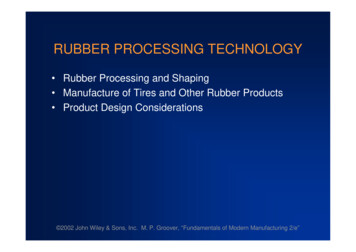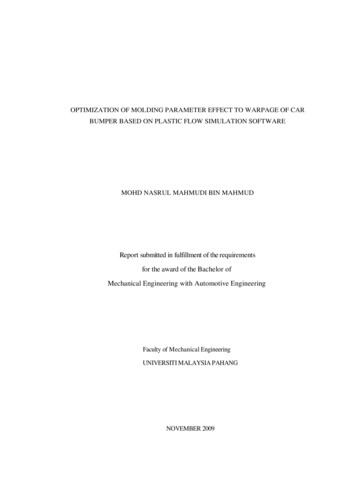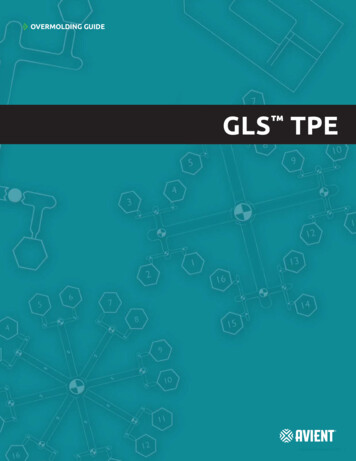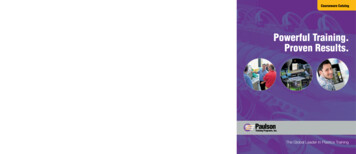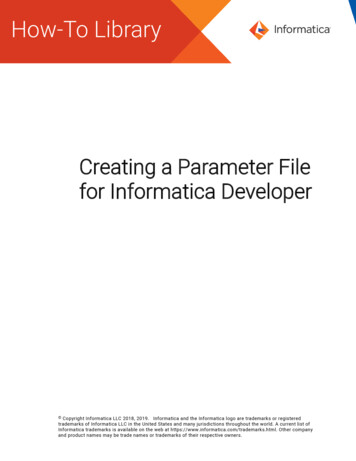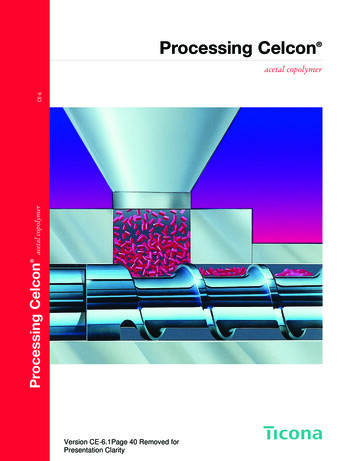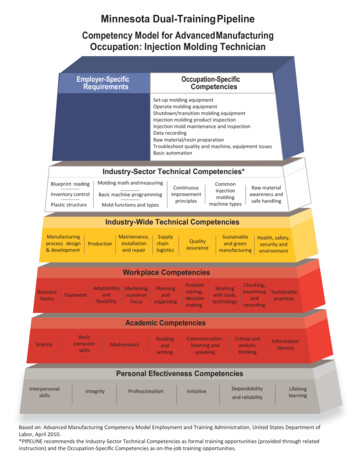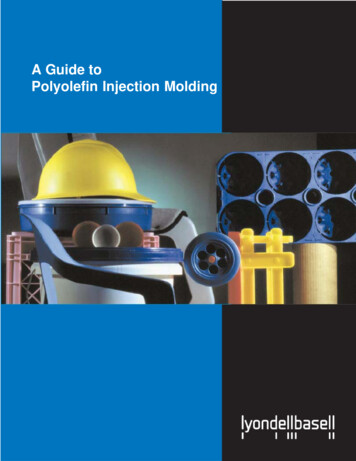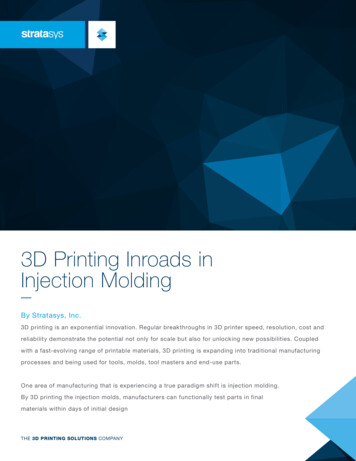
Transcription
OPTIMIZATION OF MOLDING PARAMETER EFFECT TO WARPAGE OFCAR DASHBOARD BASED ON PLASTIC FLOW SIMULATION SOFTWAREMOHD ZAHIRUDDIN BIN AZRIThesis submitted in fulfilment of the requirementsfor the award of the degree ofBachelor of Mechanical Engineering with Automotive EngineeringFaculty of Mechanical EngineeringUNIVERSITI MALAYSIA PAHANGNOVEMBER 2009
iiSUPERVISOR DECLARATIONSUPERVISOR DECLARATIONI hereby declare that I have read this report and in my opinion this report is sufficient interm of scope and quality for the award of the degree of Bachelor of MechanicalEngineering with Manufacturing Engineering.SignatureName of SupervisorPositionDate: : MADAM SITI HARYANI BT TMADI: Lecturer of Faculty Mechanical Engineering: .
iiiSTUDENT’S DECLARATIONI hereby declare that the work in this project is my own except for quotations andsummaries which have been duly acknowledged. The project has not been accepted forany degree and is not concurrently submitted for award of other degree.Signature: .Name: MOHD ZAHIRUDDIN BIN AZRIID Number: MH06069Date: 20 NOVEMBER 2009
ivDEDICATIONAnother turning point,A fork stuck in the road.Time grabs you by the wrist,Directs you where to go.So make the best of this test,And don't ask why.It's not a questionBut a lesson learned in time.It's something unpredictable,But in the end is right.I hope you had the time of your lifeEspecially dedicated toMy beloved mother and father
vACKNOWLEDGEMENTSFirst and foremost, I want to thank Allah S.W.T, for giving me the source ofpower, knowledge and strength to finish the project and dissertation for completing myBachelor of Mechanical Engineering final year project. By gradually following the planof optimization of molding parameter effect to warpage of car dashboard based onplastic flow simulation software, I’ve manage to fulfill my responsibility to this project.I would like to express my gratitude to my supervisor Madam Siti Haryani Bt.Tomadi for her wisdom, endurance and encouragement during her supervision period.She motivates me about the importance of constant and gives me her outstandingprofessional conduct. I appreciate her consistent support from the first day I applied tograduate program to these concluding moments. I am truly grateful for her progressivevision about my training in science, his tolerance of my naive mistakes, and hercommitment to my future career. I also sincerely thanks for the time spent proofreadingand correcting my many mistakes. I acknowledge my sincere indebtedness and gratitudeto my parents for their love, dream and sacrifice throughout my life. My sincere thanksgo to all my lab mates and members of the staff of the Mechanical EngineeringDepartment, UMP, who helped me in many ways and made my stay at UMP pleasantand unforgettable. And also thanks to Dean Faculty of Mechanical Engineering,Associate Prof. Dr. Rosli Bin Abu Bakar for his advice and suggestion. I also sincerelythanks for the time spent proofreading and correcting my many mistakes.I would also like to acknowledge with much appreciation the crucial role of thestaff in Mechanical Laboratory, who gave a permission to use the computer laboratoryto design and run the analysis and also the plastic laboratory to make mouldmeasurement and to use all the necessary tools in the laboratory. Special thanks toogoes to Mr. Azizuddin Bin Abd Aziz against as the Final Year Coordinator, who hasgive some advice and share his knowledge on this final year project.Many thanks go to all the supervisors who have given their full effort in guidingthe through on the project progress. I acknowledge my sincere indebtedness andgratitude to my parents for their love, dream and sacrifice throughout my life. Specialthanks should be given to my committee members. I would like to acknowledge theircomments and suggestions, which was crucial for the successful completion of thisproject.
viABSTRACTThis thesis present about the optimization of molding parameter effect to warpage of cardashboard based on plastic flow simulation software. The objective of this project is tostudy, analyze, and optimize the parameters that effect to warpage with using plasticflow simulation software. This project using the manual measurement after the originalmethod using 3D scanner cannot be done because of the technical report. Themeasurement uses the tools from the Faculty of Mechanical Engineering Laboratorysuch as ruler, vernier calliper, threads, and protractor. Then, draw the dashboard inSolidWork 2008. Using MoldFlow Plastics Insight (MPI) 5.0 software, the injectionmolding parameters are optimized to get the best parameters to minimize warpage. Thesmall changes of molding parameters will give higher impact to the plasticcharacteristics. The comparison between the types of analysis will be made. Thecomparison is between the deflections, fill times, and volumetric shrinkage including airtraps and weld lines. As the conclusion, the changes of molding parameters will affectthe warpage of the car dashboard.
viiABSTRAKTesis ini membentangkan tentang mengoptimumkan pembolehubah yang memberikesan kepada kelengkungan dasbor kereta dengan menggunakan perisian simulasipengaliran plastik. Objektif projek ini adalah mengkaji, analisis, dan mengoptimumkanpembolehubah-pembolehubah yang memberi kesan kelengkungan plastik denganmenggunakan perisian simulasi pengaliran plastik (MoldFlow Plastics Insight (MPI)5.0. Projek ini menggunakan pengukuran manual selepas perancangan asalmenggunakan alat pengimbas 3-Dimensi tidak dapat dijalankan kerana terdapat masalahteknikal. Pengukuran ini menggunakan alat-alat yang terdapat di Makmal FakultiMekanikal seperti pembaris, angkup vernier, benang, dan jangka sudut. Denganmenggunakan perisian simulasi plastik, pembolehubah-pembolehubah suntikan acuan(injection molding) adalah dioptimumkan untuk mendapatkan pembolehubahpembolehubah yang terbaik untuk mengurangkan kelengkungan. Perubahan yangsedikit terhadap pembolehubah-pembolehubah ini akan memberi kesan terdapat sifatsifat plastik. Perbandingan antara jenis-jenis kajian dibuat. Perbandingan tersebut adalahantara defleksi, masa pengisian, dan isipadu pengecutan termasuklah perangkapan udaradan sempadan penyatuan. Kesimpulannya, perubahan pembolehubah-pembolehubahmemberi kesan pelengkungan dasbor kereta.
viiiTABLE OF CONTENTSPageSUPERVISOR’S DECLARATIONiiSTUDENT’S iTABLE OF CONTENTSviiiLIST OF TABLESxiLIST OF FIGURESxiiLIST OF APPENDICESxivLIST OF SYMBOLSxvLIST OF ABBREVIATIONSxviCHAPTER 1INTRODUCTION1.1 Background of Project11.2 Objective31.3 Project Scope31.4 Problem Statement5CHAPTER 2LETERATURE REVIEW2.1 Introduction62.2 Parameters of The Molding Process92.2.1 Temperature2.2.1.1 Melt Temperature Control2.2.1.2 Mold Temperature Control2.2.1.3 Hydraulic System Temperature Control101012132.2.2 Pressure2.2.2.1 Injection Unit2.2.2.2 Clamp Unit131317
ix2.2.3 Time2.2.3.1 Gate-to-gate Cycle Time2.2.3.2 Initial Injection Time2.2.3.3 Injection Hold Time2.2.3.4 Cooling Time2.2.3.5 Ejection Time1919202021212.3 Warpage242.4 MoldFlow272.4.1 MoldFlow Plastics Insight (MPI)CHAPTER 328METHODOLOGY3.1 Introduction293.2 Proton Saga Dashboard303.3 Manual Measurement Method313.4 SolidWorks 2008323.5 Design of Experiment353.6 MoldFlow Plastics Insight (MPI) 5.0 Software353.7 Analysis36CHAPTER 4RESULT AND DISCUSSION4.1 Introduction444.2 Data444.3 Injection Pressure Analysis 464.4 Flow Rate Analysis524.5 Melt Temperature Analysis584.6 Mold Temperature Analysis64CHAPTER 5CONCLUSION AND RECOMMENDATION5.1 Conclusion705.2 Recommendation71
xREFERENCES72APPENDICES75
xiLIST OF TABLESTable No.TitlePage2.1Average times for cycle activities233.1Material properties of ABS313.2Low-middle-high values of process parameters in three-levelfull factorial design354.1Results summary for injection pressure analysis514.2Results summary for flow rate analysis574.3Results summary for melt temperature analysis634.4Results summary for mold temperature analysis69
xiiLIST OF FIGURESFigure No.TitlePage2.1Main processing parameters102.2Heating cylinder (barrel)112.3Developing injection pressure142.4Applying holding pressure152.5Applying back pressure162.6Types of shrinkage263.1Proton saga dashboard303.2Isometric view of Proton Saga Dashboard323.3Front view of Proton Saga Dashboard333.4Top view of Proton Saga Dashboard333.5Side view of Proton Saga Dashboard343.6Create new project363.7Import ‘iges’ file from CAD drawing373.8Generate the meshing entity373.9Mesh pattern appeared on Saga Dashboard (fusion)383.10Analysis sequence wizard (flow warp analysis)383.11Toyolac 100 fom ABS family have been chosen393.12Gate location393.13Runner and gate system to set up403.14Runner and gate system be done403.15Cooling system type setup413.16Complete modelling with cooling and runner system41
xiii3.17Process parameter setup423.18Perform the analysis423.19Flow chart434.1Car dashboard in MoldFlow Plastics Insight 5.0444.2Fill time for different injection pressure464.3Air traps for different injection pressure474.4Weld lines for different injection pressure484.5Deflections for different injection pressure494.6Volumetric shrinkage for different injection pressure504.7Fill time for different flow rate524.8Air traps for different flow rate534.9Weld line for different flow rate544.10Deflection for different flow rate554.11Volumetric shrinkage for different flow rate564.12Fill time for different melt temperature584.13Air trap for different melt temperature594.14Weld line for different melt temperature604.15Deflection for different melt temperature614.16Volumetric shrinkage for different melt temperature624.17Fill time for different mold temperature644.18Air trap for different mold temperature654.19Weld line for different mold temperature664.20Deflection for different mold temperature674.21Volumetric shrinkage for different mold temperature68
xivLIST OF APPENDICESAppendixTitlePageA1Gantt Chart For Final Year Project (FYP) 175A2Gantt Chart For Final Year Project (FYP) 276B1Dashboard Drawing77B2Front View of Design78B3Top View of Design79B4Right View of Design80CMoldFlow Analysis Results81
xvLIST OF SYMBOLS0CDegree Celsius%PercentMPaMega Pascalcm3/sCentimeter cubic per second
xviLIST OF ABBREVIATIONSDOEDesign of puter aided drawingCAEComputer aided engineeringFYPFinal year projectMPIMoldflow plastics insightMoTMold temperatureMeTMelt temperaturePPPacking pressurePPTPacking pressure timeCTCooling time
1CHAPTER 1INTRODUCTIONThe sole purpose of this project is to optimize molding parameter effect towarpage of car dashboard based on plastic flow simulation software. The basicperspective of this project is injection molding. The definition of this word is shapeforming process in which molten metal or plastic is injected into aluminum, ceramic, orsteel molds (shaped like the end product) and squeezed under high pressure. Injectionmolding is employed mainly in the production of solid objects.Therefore, as a student of mechanical engineering of University MalaysiaPahang, this project exposes student the field of manufacturing engineering as part ofmechanical engineering. The optimization of molding parameter is the first step to makeproduct better.1.1BACKGROUND OF PROJECTThere are several steps to finish this project. Firstly, focus on injection moldingprocess. Injection molding is the molten plastic is injected into the mold cavity to formshape with high pressure and high temperature and hold it there until the parts are cooland stiff enough to be removed from the die.The second step is molding parameters. In this case study, focus on four (4)molding parameters that needed in the injection molding. There are flow rate, injectionpressure, mold temperature, and melt temperature. These molding parameters will giveeffect to the plastic depend on how it will be control. So, the small changes of moldingparameters will give significant impact to the plastic characteristics.
2Warpage is a distortion where the surfaces of the molded part do not follow theintended shape of the design. Warpage relates to the distortion induced by theinhomogeneous shrinkage and relaxation of residual stress in the part once outside themold, shrinkage expresses the overall dimensional change as the unconstrained partcool down to ambient temperature. [1-4]There are many molding parameters effect to warpage such as mold cooling,part and mold designs, and process conditions, injection pressure, back pressure, melttemperature and mold temperature. In this case study, the molding parameters thatconsidered are stated before; flow rate, injection pressure, mold temperature, and melttemperature. All these parameters must be calculated to get the best plastic with lowestwarpage compare than before.In this case study, the needed is optimizing molding parameter effect to warpageof car dashboard based on plastic flow simulation software and reverse engineeringmethod. Reverse engineering means that the process of duplicating an existing part,subassembly, or product, without drawings, documentation, or a computer model. Italso defined as the process of discovering the technological principles of a device,object or system through analysis of its structure, function and operation. It ofteninvolves taking something apart and analyzing its workings in detail, used inmaintenance or to try to make a new device or program that does the same thing withoutcopying anything from the original. It’s used to make car dashboard more stable incontain, strength, and brittle with minimum failure. [13, 14]
31.2OBJECTIVESThe objectives of this case study are to:1. Study the parameters effect in injection molding to car dashboard2. Analyze the effect of molding parameters such as melt flow rate, injectionpressure, mould temperature and melt temperature to warpage of car dashboard.3. Optimize the molding parameters by using plastic flow simulation software inorder to get a good result.1.3PROJECT SCOPESTo start of this project, a thoroughly research of review is done with the meansof the internet, books, available published articles and materials that related to the titleand supervisor’s guidance. This is a continuing progress until sufficient knowledge isattained to complete the project.The original idea of this project is using the reverse engineering in 3D scanningexisting product in laboratory which is car dashboard. Unfortunately, the 3D scanner inthe Faculty of Mechanical Laboratory cannot be used because of the technical problem.Due to that problem, this project changed to the manual measurement method.Next is modeling the product in design software. For this project, the softwarecalled SolidWorks is chosen. SolidWorks is a 3D mechanical CAD (computer-aideddesign) program that runs on Microsoft Windows and was developed by SolidWorksCorporation. The reason using this software are solid-based solid modeler, utilizes aparametric feature-based approach to create models and assemblies. [8, 9]Here, parameters refer to constraints whose values determine the shape orgeometry of the car dashboard. Numeric parameters can be associated with each otherthrough the use of relations, which allow them to capture design intent. Building amodel in SolidWorks usually starts with a 2D sketch. The sketch consists of geometrysuch as points, lines, arcs, conics, and splines. Dimensions are added to the sketch to
4define the size and location of the geometry. Relations are used to define attributes suchas tangency, parallelism, perpendicularity, and concentricity. The parametric nature ofSolidWorks means that the dimensions and relations drive the geometry, not the otherway around. The dimensions in the sketch can be controlled independently, or byrelationships to other parameters inside or outside of the sketch. [8, 9]After do the car dashboard shape and it will analyze by using plastic flowsoftware. The flow analysis software can predict the flow of plastic throughout theinjection molding cycle to ensure that acceptable parts are designed for the manufacture.Using flow analysis, the optimizing gate locations and processing conditions assesspossible part defects, and automatically determine the dimensions for a balanced feedsystem by considering the low effects resulting from differential mold-blocktemperatures and asymmetries in part geometry. One can also determine the optimumset-up for polymer valve gate timing sequences and determine whether hot or coldrunners are appropriate.Then optimize using mold flow software.Once the plastics injection andpacking phases have been optimized, cooling circuits and a mold block- including moldinserts- can be modeled around a part for a mold cooling analysis. The mold design canbe optimized by adjusting the size and locations of cooling circuits, as well asmodifying circuit and coolant processing parameters. All the benefits of mold coolinganalysis can be applied to gas injection molded parts as well.Finally the molding process optimization can be done by using proper methodand processing condition. Thus, the molding process will produce better product in aprocess.
51.4PROBLEM STATEMENTFrom research that have been done, determine optimal process parametersettings critically influence productivity, quality, and cost of production in the plasticinjection molding industry. Previously, production engineers used trial-and-errormethod to determine optimal process parameter setting for plastic injection molding.However, this method is unsuitable in present plastic injection molding because theincreasing complexity of product design and the requirement of multi-response qualitycharacteristics. This research presents an approach in plastic flow software for theoptimization of the parameters effect to the car dashboard.In this project, what is needed is to use the plastic flow simulation software. Thissoftware includes all the information that needed in optimizing the warpage of cardashboard. After get the best result, the values of the parameters are applied toproduction line using injection molding. All these thing are very important to make surethat product can have long life time depends on its strength, capability working withhigher temperature and vibration.
6CHAPTER 2LITERATURE REVIEW2.1INTRODUCTIONFor the injection molding cycle to begin, four criteria must be met: mold open,ejector pins retracted, shot built, and carriage forward. When these criteria are met, thecycle begins with the mold closing. This is typically done as fast as possible with a slowdown near the end of travel. Mold safety is low speed and low pressure mold closing. Itusually begins just before the leader pins of the mold and must be set properly toprevent accidental mold damage. When the mold halves touch clamp tonnage is built.Next, molten plastic material is injected into the mold. The material travels into themold via the sprue bushing, and then the runner system delivers the material to the gate.The gate directs the material into the mold cavity to form the desired part. This injectionusually occurs under velocity control.When the part is nearly full, injection control is switched from velocity controlto pressure control. This is referred to as the pack/hold phase of the cycle. Pressure mustbe maintained on the material until the gate solidifies to prevent material from flowingback out of the cavity. Cooling time is dependent primarily on the wall thickness of thepart but also depends on the material being molded. Production molding usuallyrequires faster cooling. Water is often channeled throughout the dies to produce fastercooling times. During the cooling portion of the cycle after the gate has solidified,plastication takes place.
7Plastication is the process of melting material and preparing the next shot. Thematerial begins in the hopper and enters the barrel through the feed throat. The feedthroat must be cooled to prevent plastic pellets from fusing together from the barrelheat. The barrel contains a screw that primarily uses shear to melt the pellets andconsists of three sections. The first section is the feed section which conveys the pelletsforward and allows barrel heat to soften the pellets. The flight depth is uniform anddeepest in this section. The next section is the transition section and is responsible formelting the material through shear. The flight depth continuously decreases in thissection, compressing the material. The final section is the metering section whichfeatures a shallow flight depth, improves the melt quality and color dispersion. At thefront of the screw is the non-return valve which allows the screw to act as both anextruder and a plunger. When the screw is moving backwards to build a shot, the nonreturn assembly allows material to flow in front of the screw creating a melt pool orshot. During injection, the non-return assembly prevents the shot from flowing backinto the screw sections.Once the shot has been built and the cooling time has timed out, the mold opens.Mold opening must occur slow-fast-slow. The mold must be opened slowly to releasethe vacuum that is caused by the injection molding process and prevent the part fromstaying on the stationary mold half. This is undesirable because the ejection system ison the moving mold half. Then the mold is opened as far as needed, if robots are notbeing used, the mold only has to open far enough for the part to be removed. Aslowdown near the end of travel must be utilized to compensate for the momentum ofthe mold. Without slowing down the machine cannot maintain accurate positions andmay slam to a stop damaging the machine. Once the mold is open, the ejector pins aremoved forward, ejecting the part. When the ejector pins retract, all criteria for a moldingcycle have been met and the next cycle can begin.[11]The basic injection cycle is as follows: Mold close – injection carriage forward – injectplastic – metering – carriage retract – mold open – eject part(s) Some machines are runby electric motors instead of hydraulics or a combination of both. The water-coolingchannels that assist in cooling the mold and the heated plastic solidifies into the part.
8Improper cooling can result in distorted molding. The cycle is completed when the moldopens and the part is ejected with the assistance of ejector pins within the mold.The raw material for injection molding is most commonly supplied in pellet orgranule form. Pellets are poured into the feed hopper, a large open bottomed container,which is attached to the back end of a cylindrical, horizontal barrel. A screw within thisbarrel is rotated by a motor, feeding pellets up the screw's grooves. The depth of thescrew flights decreases toward the end of the screw nearest the mold, compressing theheated plastic. As the screw rotates, the pellets are moved forward in the screw and theyundergo extreme pressure and friction which generates most of the heat needed to meltthe pellets. Electric heater bands attached to the outside of the barrel assist in the heatingand temperature control during the melting process.The channels through which the plastic flows toward the chamber will alsosolidify, forming an attached frame. This frame is composed of the sprue, which is themain channel from the reservoir of molten resin, parallel with the direction of draw, andrunners, which are perpendicular to the direction of draw, and are used to conveymolten resin to the gate(s), or point(s) of injection. The sprue and runner system can becut or twisted off and recycled, sometimes being granulated next to the mold machine.Some molds are designed so that the part is automatically stripped through action of themold.Optimizing the parameters for injection molding will ensure quality products,with minimum of molded-in-stress, at lower manufacturing cost. All parameteradjustment will have an effect (positive or negative) on the physical and aestheticproperties of the molded product. Understanding this relationship allows the molder tomanipulate the properties to meet specific requirement establish for the product.
2.4 MoldFlow 27 2.4.1 MoldFlow Plastics Insight (MPI) 28 CHAPTER 3 METHODOLOGY 3.1 Introduction 29 3.2 Proton Saga Dashboard 30 3.3 Manual Measurement Method 31 3.4 SolidWorks 2008 32 3.5 Design of Experiment 35 3.6 MoldFlow Plastics Insight (MPI) 5.0 Software 35 3.7 Analysis 36 CHAPTER 4 RESULT AND DISCUSSION 4.1 Introduction 44 4.2 Data 44
